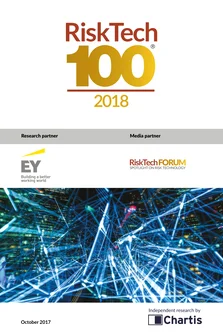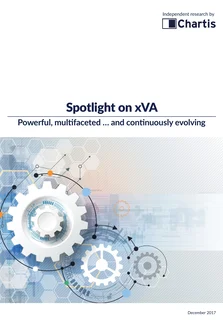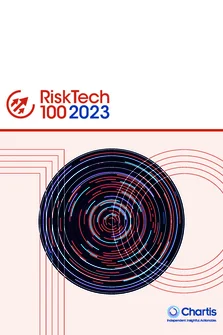<p><strong>A complex tangle of embedded components</strong></p>
<p>Over the past three decades, Front Office Risk Management (FORM) has developed in a piecemeal way. As a result of historical business drivers and the varying needs of teams focused on different products within banks, FORM systems were created for individual business silos, products and trading desks. Typically, different risk components and systems were entwined and embedded within trading systems and transaction processing platforms, and ran on different analytics, trade capture and data management technology. As a result, many banks now have multiple, varied and overlapping FORM systems.</p>
<p>Increasingly, however, FORM systems are emerging as a fully fledged risk solution category, rather than remaining as embedded components inside trading systems or transactional platforms (although those components still exist). In this report we will:</p>
<ul>
<li>Provide a definition of the category itself.</li>
<li>Examine the drivers that have enabled this solution category to emerge.</li>
<li>Consider FORM’s links to enterprise risk.</li>
<li>Analyze the impact of available FORM technology.</li>
<li>Assess institutions’ front office risk technology requirements, principally from the perspective of sell-side firms (banks and/or broker dealers).</li>
</ul>
<p>We will argue that for many institutions FORM, along with the front-office operating environment, has fundamentally changed following the global financial crisis of 2008. Banks are now dealing with a wider environment of systemically reduced profitability in which cluttered and inefficient operating models are no longer sustainable, and there are strong cost pressures for them to simplify their houses.</p>
<p>Equally, a more stringent and prescriptive regulatory environment is having significant direct and indirect impacts on front-office risk technology. Because of regulators’ intense scrutiny of banks’ capital management, the front office is continuously and far more acutely aware of its capital usage (and cost), and this is having a fundamental impact on the way the systems it uses are evolving. The imperative for risk-adjusted pricing means that traditional trading systems are struggling to cope with the growing importance and demand for Valuation Adjustment (xVA) systems at scale. Meanwhile, regulations such as the Fundamental Review of the Trading Book (FRTB) will have profound implications for front-office risk systems.</p>
<p>As a result of these direct and indirect regulatory pressures, several factors are changing the frontoffice risk technology landscape:</p>
<ul>
<li>The scale and complexity involved in data management.</li>
<li>Requirements for more computational power.</li>
<li>The imperative for integration and consistency with middle-office risk systems.</li>
</ul>
<p><strong>Evolving to survive</strong></p>
<p>As banks recognize the need for change, FORM is slowly but steadily evolving. Banks can no longer put off upgrades to systems that were built for a different era, and consensus around the need for a flexible, cross-asset, externalized<sup>1</sup> front-office risk system has emerged.</p>
<p>Over the past few years, most Tier 1 and Tier 2 banks have started working toward the difficult goal of standardizing, consolidating and externalizing their risk systems, extracting them from trading and transaction processing platforms (if that’s where they existed). These efforts are complicated by the nature of FORM – specifically that it cuts across several functional areas.</p>
<p>Vendors, meanwhile, are struggling with the challenges of meeting the often contradictory nature of front-office demands (such as the need for flexibility vs. scalability). As the front-office risk landscape shifts under the weight of all these demand-side changes, many leading vendors have been slow to adapt to the significant competitive challenges. Not only are they dealing with competition from new market entrants with different business models, in many instances they are also playing catchup with more innovative Tier 1 banks. What’s more, the willingness to experiment and innovate with front-office risk systems is now filtering down to Tier 2s and smaller institutions across the board. Chartis is seeing an increase in ‘build and buy’ hybrid solutions that leverage open-source and open-HPC<sup>2 </sup>infrastructure.</p>
<p>The rapid development of new technologies is radically altering the dynamics of the market, following several developments:</p>
<ul>
<li>A wave of new, more focused tools.</li>
<li>Platforms that leverage popular computational paradigms.</li>
<li>Software as a Service (SaaS) risk systems.</li>
</ul>
<p>More often than not, incumbent vendors are failing to harness the opportunities that these technologies and new open-source languages bring, increasing the risk that they could become irrelevant within the FORM sector.</p>
<p>Chartis contends that, as the market develops, the future landscape will be dominated by a combination of agile new entrants and existing players that can successfully transform their current offerings. Vendors have many different strategies in evidence, but the evolution required for them to survive and flourish has only just begun.</p>
<p>With that in mind, we have outlined several recommendations for vendors seeking to stay relevant in the new front-office risk environment:</p>
<ul>
<li>Above all, focus on an open, flexible environment.</li>
<li>Create consistent risk data and risk factor frameworks.</li>
<li>Develop highly standardized interfaces.</li>
<li>Develop matrices and arrays as ‘first-class constructs’.</li>
<li>Embrace open-source languages and ecosystems.</li>
<li>Consider options such as partnerships and acquisitions to acquire the requisite new skills and technology capabilities in a relatively short period of time.</li>
</ul>
<p>This report uses Chartis’ RiskTech Quadrant<sup>® </sup>to explain the structure of the market. The RiskTech Quadrant<sup>®</sup> uses a comprehensive methodology of in-depth independent research and a clear scoring system to explain which technology solutions meet an organization’s needs. The RiskTech Quadrant<sup>®</sup> does not simply describe one technology solution as the best risk-management solution; it has a sophisticated ranking methodology to explain which solutions would be best for buyers, depending on their implementation strategies.</p>
<p>This report covers the leading providers of FORM technology: Beacon, Bloomberg, Calypso, Finastra, FINCAD, FIS, Hanweck, IHS Markit, Intellect Design, MSCI, Murex, Numerix, Openlink, Orchestrade, Quantifi, RiskVal, StatPro, Thomson Reuters and TriOptima.</p>
<p><em><sub>1 - From trading and transaction management platforms.<br />
2 - High-Performance Computing</sub></em></p>
Only users who have a paid subscription or are part of a corporate subscription are able to print or copy content.
To access these options, along with all other subscription benefits, please contact info@risk.net or view our subscription options here: http://subscriptions.risk.net/subscribe
You are currently unable to print this content. Please contact info@chartis-research.com to find out more.
You are currently unable to copy this content. Please contact info@chartis-research.com to find out more.
Copyright Infopro Digital Limited. All rights reserved.
As outlined in our terms and conditions, https://www.infopro-digital.com/terms-and-conditions/subscriptions/ (point 2.4), printing is limited to a single copy.
If you would like to purchase additional rights please email info@chartis-research.com
Copyright Infopro Digital Limited. All rights reserved.
You may share this content using our article tools. As outlined in our terms and conditions, https://www.infopro-digital.com/terms-and-conditions/subscriptions/ (clause 2.4), an Authorised User may only make one copy of the materials for their own personal use. You must also comply with the restrictions in clause 2.5.
If you would like to purchase additional rights please email info@chartis-research.com





